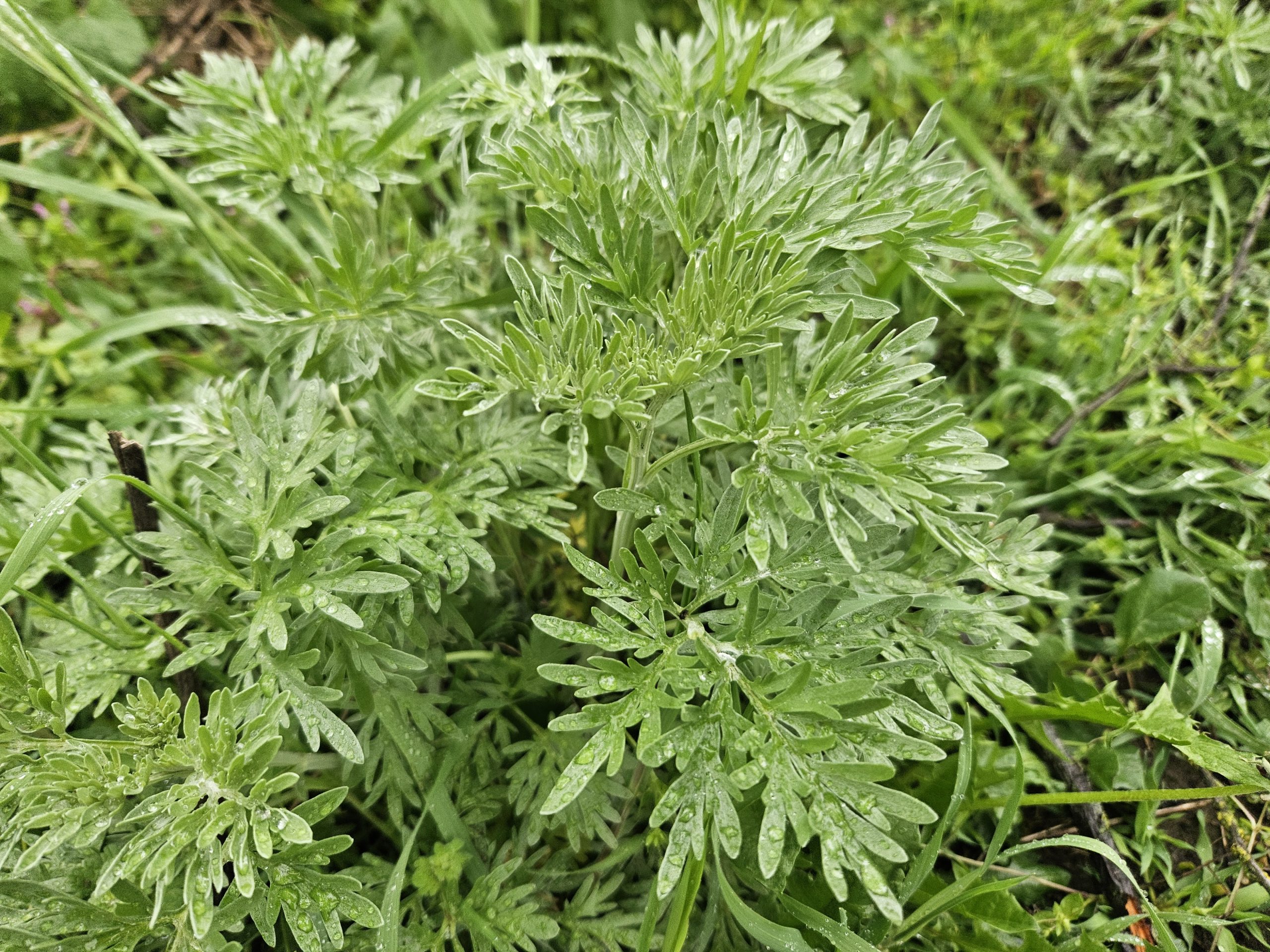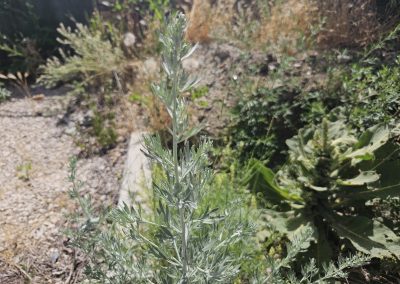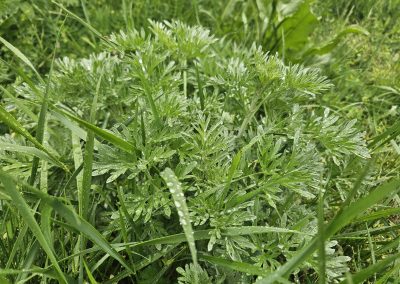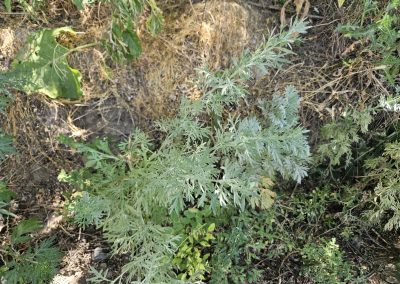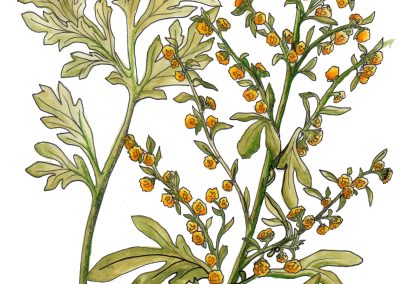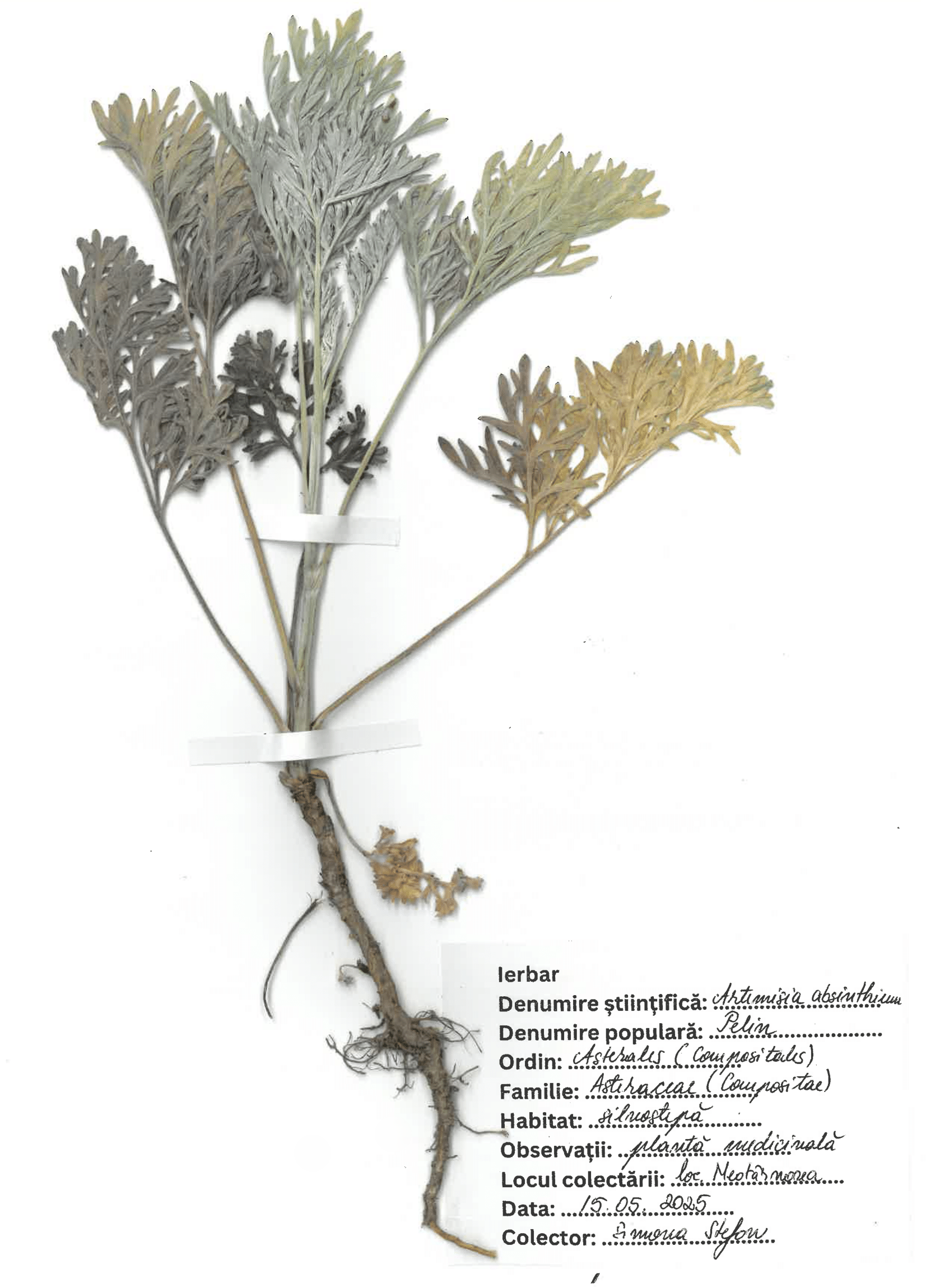Artemisia absinthium
Scientific description
Taxon: Angiospermatophyta (Magnoliophyta)
Class: Dicotyledonatae (Magnoliatae)
Subclass: Asteridae
Order: Asterales (Compositales)
Family: Asteraceae (Compositae)
Common name: wormwood, white wormwood
Origin: Eurasian
Description:
It is a perennial, robust herbaceous plant, reaching heights of 0.5–1.2 m. It has deep-penetrating taproots. The stem is hairy, erect. The leaves are also hairy, bi or tri-pinnately divided, lanceolate. Both the stem and leaves have a gray-white color due to dense and silky hairs. The flowers are yellow, arranged in small corymb inflorescences, which are further arranged in racemes at the top of the stems. The entire plant has a characteristic odor. It blooms in June–July.
Propagation: Seeds
Ecology:
It grows in ruderal places, on uncultivated lands in plains and hills. It thrives in sunny and dry areas, on neutral soils.
Use:
Plant extracts are used to prepare an alcoholic beverage called absinthe, and together with other plants, in the production of vermouth. Since ancient times, it has been a well-known medicinal plant. The aerial parts are recommended for hypochlorhydric gastritis, anorexia, digestive atony, vomiting, renal edema, gout. Externally, it is used for purulent wounds and hemorrhoids.
Threat: It is a thermophilic plant, threatened by excessive agriculturalization.
Încrengătura: Angiospermatophyta (Magnoliophyta)
Clasa: Dicotyledonatae (Magnoliatae)
Subclasa: Asteridae
Ordinul: Asterales (Compositales)
Familia: Asteraceae (Compositae)
Denumire populară: pelin, pelinul alb
Originea: euroasiatică
Descrierea:
este o plantă ierboasă, perenă, robustă, cu înălțimi de 0,5–1,2 m. Rădăcinile sunt pivotante, pătrund adânc în sol. Tulpina este păroasă, dreaptă. Frunzele sunt păroase, bi sau tripenat sectate, lanceolate. Tulpina și frunzele au culoarea alb-cenușie datorită perilor deși și mătăsoși. Florile sunt galbene, dispuse în inflorescențe calatidii mici, grupate în raceme, la vârful tulpinilor. Întreaga plantă are un miros caracteristic. Înflorește în iunie–iulie.
Înmulțire: semințe
Ecologia:
crește în locuri ruderale, pe terenuri necultivate, din zona de câmpie și deal. Vegetează bine în zone însorite și uscate, pe soluri neutre.
Utilizare:
extrasele se folosesc pentru absint și vermut. Plantă medicinală cunoscută din antichitate. Părțile aeriene se recomandă pentru gastrite hipoacide, anorexie, atonie digestivă, vomă, edeme renale, gută, iar extern pentru plăgi purulente și hemoroizi.
Pericol: este o plantă termofilă, amenințată de agriculturalizarea excesivă.
Γένος: Angiospermatophyta (Magnoliophyta)
Τάξη: (Magnoliatae)
Υποκατηγορία: Asteridae
Τάξη: Asterales (Compositales)
Οικογένεια: Asteraceae (Compositae)
Δημοφιλής ονομασία: wormthorn, white wormthorn
Καταγωγή: Ευρασία
Περιγραφή:
Είναι ποώδες, πολυετές, ανθεκτικό βότανο με ύψος 0,5–1,2 μ. Οι ρίζες είναι πασσαλώδεις και διεισδύουν βαθιά στο έδαφος. Το στέλεχος είναι τριχωτό, όρθιο. Τα φύλλα είναι επίσης τριχωτά, διπλά ή τριπλά πτεροσχιδή, λογχοειδή. Στέλεχος και φύλλα έχουν γκριζόλευκο χρώμα λόγω των μεταξένιων τριχών. Τα άνθη είναι κίτρινα, σε μικρές ταξιανθίες κορύμβων, που σχηματίζουν τσαμπιά στις κορυφές των βλαστών. Όλο το φυτό έχει χαρακτηριστική οσμή. Ανθίζει Ιούνιο–Ιούλιο.
Πολλαπλασιασμός: σπόροι
Οικολογία:
αναπτύσσεται σε αγροτικές, ακαλλιέργητες, πεδινές και λοφώδεις περιοχές. Ευδοκιμεί σε ηλιόλουστα και ξηρά εδάφη, ουδέτερα εδάφη.
Χρήσεις:
τα εκχυλίσματα χρησιμοποιούνται για αψέντι και βερμούτ. Φαρμακευτικό φυτό γνωστό από την αρχαιότητα. Τα εναέρια μέρη συνιστώνται για γαστρίτιδα, ανορεξία, πεπτική ατονία, εμετούς, οίδημα νεφρών, ουρική αρθρίτιδα. Εξωτερικά, για πυώδεις πληγές και αιμορροΐδες.
Κίνδυνος: θερμόφιλο φυτό, απειλείται από υπερκαλλιέργεια.
Taxon : Angiospermatophyta (Magnoliophyta)
Classe : Dicotyledonatae (Magnoliatae)
Sous-classe : Asteridae
Ordre : Asterales (Compositales)
Famille : Asteraceae (Compositae)
Nom commun : Absinthe, armoise amère
Origine : Eurasie
Description :
L’Artemisia absinthium est une plante herbacée vivace et robuste, atteignant 0,5–1,2 m de hauteur. Elle possède une racine pivotante profonde. Tige dressée, velue. Feuilles également velues, bi ou tri-pennées, lancéolées. Tige et feuilles gris-blanc à cause des poils soyeux. Fleurs jaunes en petits corymbes, regroupés en grappes aux sommets. Toute la plante dégage une odeur caractéristique. Floraison : juin–juillet.
Multiplication : graines
Écologie :
pousse dans les friches, terrains incultes de plaines et collines. Apprécie les zones ensoleillées, sèches, sols neutres.
Utilisation :
extraits utilisés pour absinthe et vermouth. Plante médicinale connue depuis l’Antiquité. Parties aériennes recommandées pour gastrite hypochlorhydrique, anorexie, atonie digestive, vomissements, œdèmes rénaux, goutte. Usage externe : plaies purulentes, hémorroïdes.
Menaces : plante thermophile, menacée par l’intensification agricole.
Creative writing inspired by Arctium Lappa
Written by Andrada-Alexandra Lica
The Bitterness That Heals
It is said that long ago, when people stopped listening to the voice of the earth and women’s suffering was swallowed by silence, an ancient being descended from the mountains. She was neither human nor shadow — something between a star and the wind. She wore a cloak of silver leaves, and her footsteps left no trace. They called her Artemis, but few dared speak her name aloud. She appeared only when the forests wept and the trees bent low in prayer.
Artemis wandered from village to village, searching for forgotten girls, wounded mothers, and souls scorched by shame. She rarely spoke, yet in her gaze lived a stillness that soothed all pain. It was said that if she touched your forehead, your dreams would take root in the soil and grow into healing plants.
One day, in a village bruised by war and sorrow, Artemis found a young woman named Elina. She was sickly and pale, with eyes that had long since stopped looking at the world. She had not spoken in weeks. She flinched at light. The villagers called her cursed.
Without a word, Artemis gathered leaves from a bitter plant — narrow, silver-green, with a sharp, earthy scent. She boiled them in clean water and brought the warm brew to Elina’s lips. The girl cried. Deeply. Bitterly. And in those tears, memories poured out — everything she had buried to survive. Then she slept for three days. When she awoke, she smiled faintly.
“What was that?” she asked.
“The bitterness that heals,” Artemis replied. “You will learn to carry it like armor.”
Artemis left that same night and was never seen again. But where she walked, delicate silver-leafed plants began to sprout. They called it wormwood and the women gathered it in silence, for wounds no one else could see.
Even now, it is said that when you sip wormwood tea and taste its sharpness, it doesn’t only heal your body — it heals something deeper. For Artemis did not die. She became every bitter leaf, every woman who stood again after being broken.


